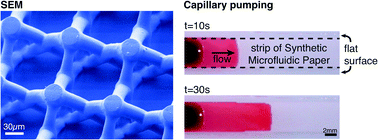Synthetic microfluidic paper: high surface area and high porosity polymer micropillar arrays†
Abstract
We introduce Synthetic Microfluidic Paper, a novel porous material for microfluidic applications that consists of an OSTE polymer that is photostructured in a well-controlled geometry of slanted and interlocked micropillars. We demonstrate the distinct benefits of Synthetic Microfluidic Paper over other porous microfluidic materials, such as nitrocellulose, traditional paper and straight micropillar arrays: in contrast to straight micropillar arrays, the geometry of Synthetic Microfluidic Paper was miniaturized without suffering capillary collapse during manufacturing and fluidic operation, resulting in a six-fold increased internal surface area and a three-fold increased porous fraction. Compared to commercial nitrocellulose materials for capillary assays, Synthetic Microfluidic Paper shows a wider range of capillary pumping speed and four times lower device-to-device variation. Compared to the surfaces of the other porous microfluidic materials that are modified by adsorption, Synthetic Microfluidic Paper contains free thiol groups and has been shown to be suitable for covalent surface chemistry, demonstrated here for increasing the material hydrophilicity. These results illustrate the potential of Synthetic Microfluidic Paper as a porous microfluidic material with improved performance characteristics, especially for bioassay applications such as diagnostic tests.



 Please wait while we load your content...
Please wait while we load your content...